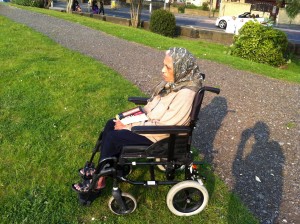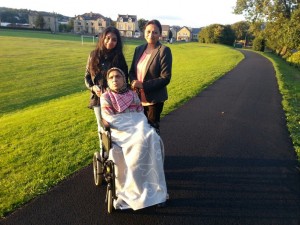Dementia has an impact on many lives, but so few are willing to come forward and talk about this cruel, debilitating disease. Local community activist Siddiq Birader, who has spent the past four years looking after his mother Amina, speaks out about the heart wrenching experience of seeing his mother struggle. And his fight to secure a path so that she could be taken for walks around the historic Savile Town field.
By Siddiq Birader
 Dementia is a condition none of us envisage affecting our lives, at least not until it falls upon a loved one.
Dementia is a condition none of us envisage affecting our lives, at least not until it falls upon a loved one.
25 million people or 42% of the UK population know a close friend or family member with dementia. A condition so unforgiving it takes away your complete self-being, dignity and in one sense humanity.
To suffer with this cruel condition and to see one suffering is equally the same. But to see a loved one suffer is soul shattering.
As a carer your life is brought to a standstill. All of a sudden you are thrown in to this world of making the most difficult decisions of your life. What do you do?
But how could I pass the buck, when the one in question is my own Mother. The one who suffered more pain than anyone can imagine bringing me into this world, only now to be afflicted with a disease that will soon deal a cruel twist of fate by transforming her in to a child as time goes on.Questions make your mind spin like the vortex of a Hurricane, leaving you feeling just as helpless as the one who is actually suffering this cruel disease. Do you take up the responsibility of looking after this person or do you pass the buck onto someone else?
That thought alone made the decision easy, as easy as breathing. But even then I could not imagine what was to fall into both of our worlds.
THE DAY OUR LIVES TURNED UPSiDE DOWN
It was four years ago that my family was given the devastating news that our mother had been diagnosed with Stage One Dementia & Alzheimer’s.
Living alone with my father in Blackburn we knew as a family that she needed to be around her family in order for her to be looked after. The transition at the time from bringing her to live with us from Blackburn was fairly easy. She was still mobile and talking, although getting confused and agitated at the smallest of incidents.
Why have we brought her here? Why couldn’t we just take her home? Repeating the same questions a dozen times. But slowly she began to settle with us here.But as the months passed, life changed for all of us in our home. Routines changed in order to adapt to her way of life. Questions were repeated and we had to find an extra level of patience, giving her the same answers over and over again.
SACRiFICES OF CARING
I had to make the tough decision of giving up work to be at home as there was no way we could leave her on her own. As time passed, the other one of us had to reduce to working part-time hours with work. Something we never thought we would have to do in the immediate future.
But in the midst of this worrying and most certainly demanding time, we’ve never felt alone.
The support from Alzheimer’s & Dementia Society, Local NHS Trust, Admiral Nurses, Social Services and the local Privilege Care Agency has been invaluable. From support with resources available, to coping techniques for us, we are certain that without them we would be struggling now.
I wanted to ensure that mum retained as much “normality” as possible, but even taking her out for a walk or to visit family & friends would soon become a struggle. Her mobility was changing, firstly walking at a snail’s pace only for us to soon find that she would completely stop one day. Who could have ever have imagined this day would come?
WALKING TALL
We started taking her for walks in her wheelchair; however going around Savile Town didn’t provide the most scenic of routes, for either mum or I.
My mum loved the countryside but trying to manage her and the wheelchair in a car was not the easiest of tasks a
nd by the time we would reach somewhere nice or even the nearest park, she would complain of tiring or fall asleep.
I started taking her to the nearest place in Savile Town with the most greenery – the Savile Town sports field, which she seemed to enjoy. I would sit beside her, while she would sit in her wheelchair watching the children play in the park and the birds in the trees. I could see a spark in her eyes, and a change of colour in her cheeks; I could tell that even with this disease eating away at her she was happy here.
However, a few minutes would pass before she would get bored (something I believe brought on by her illness) and ask to be taken for a walk.
DIFFICULT PATH
 There was a rudimentary, rutted path of scalping laid around the perimeter of the field. But it was virtually impossible to push a wheelchair over it – I tried numerous times to no avail.
There was a rudimentary, rutted path of scalping laid around the perimeter of the field. But it was virtually impossible to push a wheelchair over it – I tried numerous times to no avail.
I noticed that a number of parents were coming for walks during the evenings with their children in prams. However due to the unmaneuverable nature of the surface of the path they would take turns to watch over each other’s children whilst the other goes for a walk.
That was the light bulb moment. There was a need for a proper path to be laid. Not just for me to give my mother the chance to enjoy different views of this historic field but also for all those who use the field, mothers with prams, joggers and wheelchair users.
CAMPAIGN
 Being a keen historian, I was heavily involved in the restoration of the Savile Town Fountain. So I spoke to Cllr Salim Patel who arranged a site visit. Following this Kirklees Council came back with a plan to tarmac half of the track.
Being a keen historian, I was heavily involved in the restoration of the Savile Town Fountain. So I spoke to Cllr Salim Patel who arranged a site visit. Following this Kirklees Council came back with a plan to tarmac half of the track.
Not good enough – so I flatly refused this suggestion. I continued to push the council and Cllr Patel. Then early last year I received a phone call from Cllr Patel telling me a complete tarmac path had been approved.
The path was completed in August 2013 and is now being enjoyed by all people of all kinds – an overwhelming success. As an added bonus park benches and litter bins are to be dotted around the path we’re also approved.
Due to the fantastic reaction of the local community the next step is to get Kirklees Council to approve lighting for the path, so that all of us can enjoy the field even during the small of hours of the winter months.
TRIP DOWN MEMORY LANE
 As a man with a real love of history, this path gives me real pride. This stretch of greenery is of great significance to not just Dewsbury but Yorkshire’s heritage. It was formerly the Dewsbury Cricket Ground, with a beautiful pavilion – which unfortunately no longer exists.
As a man with a real love of history, this path gives me real pride. This stretch of greenery is of great significance to not just Dewsbury but Yorkshire’s heritage. It was formerly the Dewsbury Cricket Ground, with a beautiful pavilion – which unfortunately no longer exists.
In its heyday (1867 to 1933) the ground hosted a total of 49 first-class matches, including a North v South match in 1870 and Yorkshire v Australians in 1880. Yorkshire had a particularly good record at the ground winning 31 matches and losing just five.
But whilst we can look back and enjoy the history (preceding even our own time) of this land, for some like my mother they can’t.
As a family dealt this difficult hand, we’ve tried not to let dementia beat us. We’ve chosen to look past the difficulties; instead our focus is on the immediate future – on making the remainder of our mother’s days as fulfilling and joyful as possible for her.
Whenever I see the path around this historic field being used, I’m reminded that this was initiated by my mother.
For more information about dementia care and the work of admiral nurses go to http://www.dementiauk.org/what-we-do/admiral-nurses/
